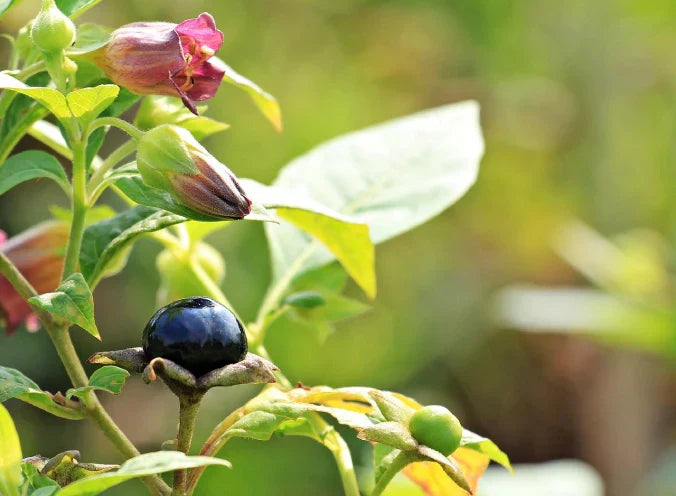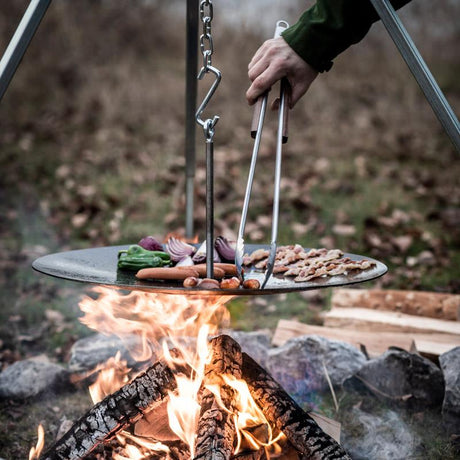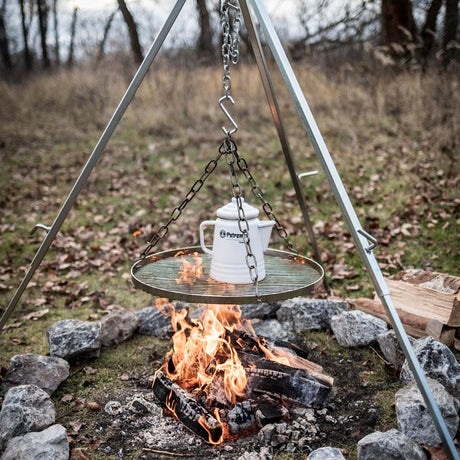Are you looking for tasty wild herbs for your kitchen? Then you should definitely know which plants you should leave standing! Not everything that grows in nature is suitable for consumption. Some wild plants can even be really dangerous. This is because distinguishing between edible and poisonous species is often a real challenge, especially for beginners in collecting wild herbs. Many of the most dangerous specimens disguise themselves as inconspicuous doppelgangers of their edible relatives.
In this detailed article, you will find out which poisonous wild plants are particularly common in Germany, how to recognize them reliably and, above all, which edible herbs they can easily be confused with.
Table of contents
Why you should know poisonous wild plants
The 7 most dangerous poisonous wild plants in Germany
First aid for poisoning by wild plants
How to collect wild herbs safely
Conclusion: Respect for nature pays off
Frequently asked questions about poisonous wild plants
Why you should know about poisonous wild plants
Collecting wild herbs is all the rage. No wonder, because nature offers a wealth of free, nutrient-rich and often healing foods right on our doorstep. Enthusiasm for "green gold" is constantly growing - from celebrity chefs to amateur gardeners, more and more people are swearing by the power of wild herbs.
But beware: there are also real dangers lurking among the tasty herbs! In the course of evolution, nature has developed sophisticated defense mechanisms. Many plants produce toxins to protect themselves from predators. These toxins can be extremely dangerous for us humans. From mild skin irritation, nausea and vomiting to severe organ damage or even cardiac arrest - the range of possible symptoms of poisoning is frighteningly wide.
Particularly treacherous: some of the most poisonous plants are confusingly similar to their edible relatives. The harmless-looking water hemlock is easily confused with the wild carrot, while the popular wild garlic has several poisonous doppelgangers. A single mistake when collecting can lead to serious poisoning and, in the worst case, even be fatal. According to the Poison Information Center North, several hundred cases of plant poisoning are reported every year - the number of unreported cases is likely to be significantly higher.
It is therefore extremely important to be able to identify the poisonous representatives before you head out into nature with your collection basket. With the right knowledge, you can minimize the risks and enjoy collecting wild herbs as an enriching hobby!
The 7 most dangerous poisonous wild plants in Germany

1 Aconite - the deadly blue bloomer
Aconite (Aconitum napellus) is not known as the "queen of poisons" for nothing. With its striking blue flowers, it may look beautiful, but it is one of the most poisonous plants in Europe. The toxicity of this plant was already known in ancient times - its Latin name is derived from Mount Akonitos, where, according to legend, the hellhound Kerberos created this deadly plant with his poisonous drool.
Even skin contact can be dangerous! Particularly treacherous: the toxins can even penetrate the body through uninjured skin. The plant contains the highly toxic alkaloid aconitine, which can be fatal even in small quantities. Just 2-4 milligrams can be fatal for an adult human - this is roughly equivalent to the amount contained in a single leaf. The symptoms of poisoning range from numbness and tingling to cardiac arrhythmia and even respiratory paralysis.
Monkshood grows mainly in mountain forests and damp locations, but is also increasingly found in gardens as an ornamental plant. In the wild, it is particularly common in the Alps and low mountain ranges, where it thrives in sparse forests, on the banks of streams and in damp mountain meadows.
How to recognize it: Striking blue, helmet-shaped flowers (hence the name "storm hat") and deeply incised, palmately divided dark green leaves with a glossy surface. The plant grows up to 150 cm tall and flowers from June to September. The stem is upright and branches out at the top.
2. angel's trumpet - dangerously beautiful funnel plant
The angel's trumpet (Brugmansia spp.) enchants with its large, funnel-shaped flowers - but behind this beguiling beauty lies one of the most dangerous ornamental plants of all. All parts of the plant contain highly concentrated tropane alkaloids (mainly scopolamine, hyoscyamine and atropine), which are strongly hallucinogenic and highly toxic. These active ingredients affect the central nervous system and can lead to hallucinations, extreme confusion, tachycardia, dilated pupils and, in the worst case, death if poisoned.
Children are particularly at risk as they are often attracted by the conspicuous, fragrant flowers. The sweet-smelling flowers exude their beguiling scent, especially on warm summer nights. Historically, extracts of angel's trumpet have been used by South American shamans for ritual purposes, but have also been abused as an intoxicant - sometimes with fatal consequences.
The plant originally comes from South America and belongs to the nightshade family (Solanaceae). Today it can be found in many gardens and on balconies as an impressive ornamental plant. In mild winters, it can also overwinter outdoors in sheltered locations in Germany, but is usually kept as a container plant.
How to recognize it: Large, drooping, trumpet-shaped flowers in white, yellow, orange, pink or apricot, which can grow up to 30 cm long. The flowers usually open in the evening and exude an intense, sweet fragrance. The plant has large, egg-shaped to lanceolate leaves with serrated edges and can grow up to 3 meters high in the form of a shrub. In contrast to the similar datura, the flowers of the angel's trumpet hang downwards.
3. belladonna - seductively dangerous berries
The deadly nightshade (Atropa belladonna) is aptly named. Its botanical name "belladonna" (beautiful woman) comes from the fact that women in the Renaissance used extracts of the plant as drops to dilate their pupils - an ideal of beauty at the time. But what was once considered a beauty remedy is actually one of the most dangerous plants in our native flora.
Its shiny, black berries look appetizing and have a sweet taste - a fatal combination, especially for children. However, they contain highly concentrated tropane alkaloids, especially atropine, hyoscyamine and scopolamine. These toxins block the parasympathetic nervous system and lead to characteristic symptoms: dilated pupils, reddened skin, increased pulse, dry mouth and, in advanced stages, hallucinations and delusions. Just two to three berries can be fatal for a child! In adults, just 10-15 berries can lead to death.
Deadly nightshade grows mainly on forest edges, in clearings and in sparse deciduous forests, especially on calcareous soils. It prefers semi-shady to shady locations and is widespread throughout Central Europe.
How to recognize it: Single, black, cherry-like, shiny berries with a characteristic five-pointed "little crown" (the calyx) at the base of the stem. The berries sit in the leaf axils and are about the size of a cherry. The flowers are bell-shaped and dirty purple to brown in color. The plant grows to a height of around 0.5 to 1.5 meters and has egg-shaped, pointed leaves that grow in pairs but in different sizes. The stem is upright and branched.
4. autumn crocus - the wild garlic lookalike
Autumn crocus (Colchicum autumnale) is particularly treacherous because its leaves can easily be mistaken for the popular wild garlic in spring - a confusion that leads to numerous cases of poisoning every year. The life-saving difference: wild garlic smells intensely of garlic if you rub the leaves between your fingers, whereas the autumn crocus does not give off a characteristic odor.
This inconspicuous plant is one of the most insidious poisonous plants in Europe. It contains the highly poisonous alkaloid colchicine, which is not even destroyed by cooking or drying. The poison has a cell-damaging effect and prevents cell division in the body. Particularly perfidious: the first symptoms of poisoning often only appear hours later, when considerable quantities of the poison have already been ingested.
Poisoning with autumn crocus typically begins with burning pain in the mouth and throat, followed by severe gastrointestinal complaints with bloody diarrhea. In severe cases, circulatory failure, kidney failure and finally death due to respiratory paralysis occur. Just 50-100 g of the leaves can be fatal for an adult.
The autumn crocus has an unusual life cycle: in the fall, the purple flowers appear directly from the ground, without leaves. The leaves only develop in the following spring together with the seed capsules - exactly when the wild garlic also sprouts its leaves. It prefers to grow in damp meadows and sparse woodland, often close to wild garlic.
How to recognize it: In spring, several elongated, lanceolate, parallel-veined, bright green leaves (3-4 per plant) appear without flowers, whereas in fall, crocus-like, purple flowers appear without leaves. The leaves have no stalks, are smooth and shiny and grow directly from the ground. In contrast to wild garlic, whose leaves sprout individually from the ground and have a distinct stem, the leaves of the autumn crocus grow in clusters directly from the bulb and are sheath-like at the base.
5. foxglove - heart poison in a beautiful shell
The red foxglove (Digitalis purpurea) is an impressive forest plant with characteristic bell-shaped flowers - and at the same time one of the most effective medicinal and poisonous plants in Europe. The name "digitalis" is derived from the Latin "digitus" (finger), as the flowers look like thimbles.
The plant contains potent cardiac glycosides, in particular digitoxin and digoxin, which can be life-saving as heart medication in the correct dosage, but can be fatal if overdosed. These active ingredients increase the heart's beating power and at the same time slow down the heartbeat - a property that is used therapeutically in heart failure. The discovery of this medicinal effect goes back to the English physician William Withering, who recognized the healing power of foxglove for dropsy (oedema) in the 18th century.
The danger lies in the extremely low therapeutic range: the difference between effective medicine and deadly poison is minimal. Eating just two or three leaves can lead to severe poisoning in adults. Symptoms range from nausea, vomiting and visual disturbances (yellow or green vision and blurred vision are characteristic) to dangerous cardiac arrhythmia and cardiac arrest.
Confusion with edible plants is relatively rare, as the foxglove looks very characteristic. However, the attractive, colorful flowers can tempt children in particular to snack on them. The young rosettes of leaves have occasionally been mistaken for comfrey or other medicinal herbs.
Foxglove prefers sparse forests, forest clearings and edges. It is often found in clearings and is a typical pioneer plant that quickly establishes itself after forest fires or clearings. The plant is a biennial: in the first year it only forms a rosette of leaves on the ground, only in the second year does it develop an inflorescence.
How to recognize it: Tall, unbranched stem with drooping, thimble-like, tubular flowers arranged on one side (unilaterally), usually purple-red or rarely white in color. The flowers have dark spots with a white border on the inside. The plant grows up to 150 cm tall and has large, elongated leaves with notched edges and soft hairs on the underside. The lower leaves form a characteristic rosette.
6. lily of the valley - dangerous confusion with wild garlic
The lily of the valley (Convallaria majalis) is one of the best-known spring flowers and can be found in many gardens as an ornamental plant. With its elongated oval, parallel-veined leaves, it looks very similar to the popular wild garlic - a confusion that leads to numerous cases of poisoning every spring. The greatest danger is in early spring, when both plants sprout their leaves, but the lily of the valley does not yet have its characteristic flowers.
The decisive difference: lily of the valley does not smell of garlic when you rub the leaves and usually has only two (rarely three) opposite leaves per plant, which grow directly from the ground. Wild garlic, on the other hand, has individual leaves with distinct stalks that smell intensely of garlic. The underside of the leaves of the lily of the valley is shiny, while those of the wild garlic are matt.
All parts of the lily of the valley plant contain over 30 different cardiac glycosides (mainly convallatoxin and convalloside), which can affect heart function in a similar way to foxglove. Poisoning initially leads to nausea, vomiting and headaches. Later on, cardiac arrhythmia, visual disturbances and, in severe cases, heart failure can occur. The red berries, which appear in the fall and can look tempting to children, are particularly dangerous.
The lily of the valley prefers to grow in sparse deciduous and mixed forests, often in similar locations to wild garlic. It often forms large populations through underground runners. In folk medicine, it used to be used as a heart medicine, but today this application is obsolete due to its limited therapeutic range.
How to recognize it: Characterized by nodding, white, bell-shaped, highly fragrant flowers on a stem that appear from May. The plant usually has two (sometimes three) broadly oval to lanceolate, parallel-veined leaves with a shiny underside that grow directly from the ground. In the fall, the lily of the valley produces orange-red berries. The plant grows to a height of around 15-25 cm. The most important distinguishing feature from wild garlic: no garlic smell when the leaves are crushed.
7. water hemlock - the deadly swamp dweller
The water hemlock (Cicuta virosa) is considered one of the most poisonous plants in Central Europe and is often referred to as the "deadliest plant in Germany". Even Socrates' famous hemlock cup did not contain this plant, but the less poisonous spotted hemlock. Water hemlock is particularly dangerous if it is confused with edible umbellifers such as wild carrot, parsnip or fennel root.
The cicutoxin contained in all parts of the plant, particularly concentrated in the rhizome, is a highly potent neurotoxin that can be fatal even in tiny quantities. Just 2-3 g of the root can kill an adult human - the equivalent of a piece the size of a hazelnut. The poisoning is dramatic: initially there is burning pain in the mouth and stomach, followed by nausea and vomiting. As the poisoning progresses, violent, epileptic-like convulsions set in, which can eventually lead to respiratory paralysis and death. The mortality rate for poisoning is over 30%.
The name "water hemlock" already indicates the plant's preferred habitat: it grows exclusively in wetlands such as bogs, swamps, ditches and on the banks of standing or slow-flowing water. It often forms large populations there. Historically, the water hemlock was involved in numerous deaths, as the root was mistaken for edible roots due to its pleasantly sweet smell and taste.
How to recognize it: White, double umbellate flowers (typical of umbellifers) with single five-petaled flowers. The stem is hollow, strong, furrowed and often reddish-spotted or blotched. The strongly chambered rhizome, which secretes a yellow, strong-smelling milky sap when cut, is particularly characteristic. The plant grows up to 150 cm tall and has double to triple pinnate, sharply serrated leaves. The leaves are somewhat similar to those of parsley, but are larger and more coarsely serrated.
First aid for poisoning by wild plants
Even with the greatest care, it can happen: Have you accidentally touched or even eaten a poisonous plant? Then you need to act quickly! Plant poisoning can be life-threatening and should never be taken lightly. Here you can find out how to react correctly in an emergency:
Immediate measures for plant poisoning
- Stay calm - panicking will only make the situation worse and lead to wrong decisions. Take a deep breath and concentrate on the necessary steps.
- Call an ambulance - If you suspect poisoning, call 112 immediately. Describe the symptoms, the time of ingestion and, if possible, the suspected plant. Every minute counts!
- Save plant remains - If possible, take parts of the plant with you or take a photo. This will help the medical staff enormously with identification and correct treatment. Also keep vomit as it can be helpful for analysis.
- Do not self-medicate - In the past it was recommended to induce vomiting or drink milk. Today, experts strongly advise against such "home remedies"! They can even make the situation worse. Only follow the instructions of the emergency doctor or the poison control center.
-
Contact a poison control center - In addition to calling the emergency services, you can also contact one of the German poison control centers. These are staffed around the clock and offer specialized advice on poisoning:
- Berlin: 030 19240
- Munich: 089 19240
- Freiburg: 0761 19240
- Göttingen: 0551 19240
- Mainz: 06131 19240
- Bonn: 0228 19240
- Erfurt: 0361 730730
- Homburg: 06841 19240
Typical symptoms of plant poisoning
The symptoms of plant poisoning can vary greatly depending on the poison and can differ greatly in their intensity. Watch out for the following warning signs:
- Gastrointestinal symptoms: Nausea, vomiting, diarrhea, abdominal cramps
- Skin reactions: Redness, swelling, itching, blistering
- Circulatory problems: dizziness, drop in blood pressure, rapid or irregular pulse
- Respiratory symptoms: Shortness of breath, coughing, feeling of suffocation
- Neurological symptoms: headache, drowsiness, confusion, convulsions, hallucinations
- Visual disturbances: blurred vision, dilated or constricted pupils, color vision
Important: Symptoms of poisoning can develop with a time delay. Sometimes they only appear hours after contact with the plant. Therefore, take even seemingly mild symptoms seriously and seek medical help!
How to collect wild herbs safely
Collecting wild herbs should be fun and not involve any risks. With the right knowledge and a few precautions, you can enjoy nature's treasures without any worries. Here you will find important tips to help you collect them safely and responsibly:
The golden rules for safe collecting
- Know your plants with absolute certainty - only collect plants that you can identify beyond doubt. If in doubt, always leave them standing! No wild herb salad is worth risking your health. Get to know a few species really well before expanding your repertoire.
- Invest in good identification books - A high-quality plant book with detailed illustrations and clear descriptions is worth its weight in gold. We recommend special wild herb guides with possible confusions. Look out for editions with color photos instead of drawings and books that also point out poisonous doppelgangers.
- Use modern aids - There are now excellent apps for plant identification that can make suggestions based on photos. However, these should only be used as an additional aid and never as the sole source! Popular apps are "PlantNet", "Flora Incognita" or "PictureThis". Online forums for wild herb collectors can also be helpful.
- Take part in herb tours - learn from experienced experts! There is no substitute for identifying plants together on site under expert guidance. Many adult education centres, nature conservation associations or specialized herb educators offer such excursions. Here you will not only get to know the plants, but also valuable tips on locations, collection times and possible uses.
- Pay attention to the right collection time - Many plants should only be collected at certain times of the year when they are at their best and can be identified most easily. Some plants, such as wild garlic, disappear completely after flowering and can then no longer be found.
- Collect in safe places - avoid busy roads (at least 50 metres away), industrial areas, agricultural land where pesticides may be used, dog exercise areas and freshly fertilized meadows. Ideal collection sites are natural forests, forest edges and extensively managed meadows.
- Use the right tools - a sharp knife or small garden shears for clean cutting, gloves for prickly or allergenic plants and air-permeable collection containers such as baskets instead of plastic bags ensure a fresh yield and protect the plants.
- Respect nature conservation rules - only collect for your own use and never in nature reserves. Leave enough plants to allow the stock to regenerate (rule of thumb: never harvest more than a third of a stock). Protect rare species by leaving them standing, even if they are edible.
- Observe legal requirements - In Germany, you are only allowed to collect small quantities for personal use in the wild. In private forests and on agricultural land, you need the owner's permission.
Minimize the risk of confusion - How to recognize edible plants safely
- Use all your senses - Pay attention not only to the appearance of a plant, but also to its smell, surface structure and location. The characteristic garlic smell of wild garlic, for example, is the surest way to distinguish it from poisonous lookalikes.
- Check the typical features - Every plant has characteristic identifying features such as leaf shape, leaf position, flower shape, stem shape or special features such as hairiness, spines or milky sap. Get to know these in detail.
- Get to know the plant families - plants in the same family often share certain characteristics. For example, umbellifers such as wild carrot and the poisonous water hemlock have characteristic umbellate flowers. Labiates (e.g. mint, thyme) have typical two-lipped flowers and square stems.
- Only collect plantsonce you have identified them with certainty - only pick a plant once you have identified it without a doubt directly at the location. Never take unknown plants home and "identify them later"!
Conclusion: Respect for nature pays off
Collecting wild herbs is a wonderful way to experience nature, strengthen our connection to the plant world and enrich our diet with healthy, natural ingredients. Wild herb cuisine is experiencing a renaissance for a reason - not only does it taste great, but it also gives us back some of the independence and knowledge of natural resources that has been increasingly lost in our modern society.
However, as with everything in life, with great pleasure comes great responsibility. Nature has developed its own rules and protective mechanisms. Poisonous plants are not a malicious attack on collectors, but the result of evolutionary development for self-protection. We should respect these natural limits and approach collecting with the necessary knowledge and caution.
The poisonous plants presented in this article are only a small selection of the potentially dangerous species in our native flora. However, they are among the most common and most dangerous representatives that wild herb collectors in Germany can come into contact with. The potential for confusion with popular edible plants such as wild garlic, wild carrot or edible berries is particularly treacherous.
Therefore, inform yourself thoroughly before you set off in search of wild herbs. Invest in good identification books, take part in herb tours and start with a few, easily recognizable species that do not have any dangerous doppelgangers. With increasing knowledge and experience, you can then gradually expand your repertoire.
With the right preparation, the necessary respect and a healthy dose of caution, nothing will stand in the way of your next gathering adventure. Nature offers an inexhaustible treasure trove of edible wild plants that are just waiting to be discovered by you - without the poisonous representatives having to get in your way.
Frequently asked questions about poisonous wild plants
Which poisonous plants are most often confused with edible plants?
The most dangerous and most frequent mix-ups occur between wild garlic and its poisonous doppelgangers lily of the valley and autumn crocus. This is because all three grow in similar locations in early spring and their leaves bear a certain resemblance. The characteristic garlic smell of wild garlic is the most important distinguishing feature here.
Water hemlock is also sometimes mistaken for wild carrot or other edible umbellifers such as parsnips. The confusion of the roots is particularly dangerous here. The wild strawberry has a poisonous doppelganger in the mock strawberry, whose fruits are not highly poisonous but are inedible.
In the fall, poisonous mushrooms are occasionally mistaken for edible ones - a topic that would deserve its own detailed article, as special caution is required here.
Are all poisonous plants also dangerous to touch?
No, most poisonous plants are only dangerous when eaten and can be touched without hesitation. However, there are important exceptions where even skin contact can be problematic:
Monkshood is so highly poisonous that its active ingredients can be absorbed through even minor skin injuries or, in the case of prolonged contact, through uninjured skin. Gloves should always be worn when collecting aconites.
The giant hogweed contains phototoxic substances which, in combination with sunlight, can lead to severe skin reactions similar to burns. Here too, any skin contact should be avoided.
Spurges also secrete a white milky sap that can cause skin irritation in sensitive people. Although stinging nettles cause painful wheals, they are not poisonous in the true sense of the word.
As a rule of thumb, always wear gloves when handling unknown plants and wash your hands thoroughly after collecting them before touching your face or eating.
How can I tell the difference between wild garlic and poisonous lookalikes?
The characteristic garlic smell when the leaves are crushed is the safest and most important distinguishing feature of wild garlic. Neither lily of the valley nor autumn crocus smell like garlic.
There are also other clear differences:
- Wild garlic: each leaf grows individually from the ground with a distinct stalk. The underside of the leaf is matt, the leaves are soft and flexible. The cross-section of the leaf stalk is semicircular.
- Lily of the valley: Usually two (sometimes three) leaves grow together from the ground and enclose each other like a sheath at the base. The underside of the leaf is glossy, the leaves are relatively firm.
- Autumn crocus: Several leaves (3-4) emerge together from a bulb and enclose each other in a sheath. The leaves are thicker and firmer than wild garlic leaves.
In addition, wild garlic often grows over large areas in dense stands, whereas lily of the valley usually grows in smaller groups.
Can children be endangered by simply touching poisonous plants?
With most poisonous plants, the risk from simply touching them is low. Nevertheless, children should generally learn not to touch unknown plants and not to put their hands in their mouths or touch their faces afterwards. This is particularly important with plants such as monkshood or giant hogweed, which can also release toxins through the skin.
Young children often intuitively put things in their mouths, so they should always be supervised in nature. Children can be taught from an early age not to eat anything from nature without asking an adult first. Garden plants with attractive but poisonous berries such as deadly nightshade, privet or yew pose a particular danger here and should be avoided in gardens with small children.
Where can I get help if I suspect poisoning?
If you suspect poisoning, you should call 112 immediately. Describe the symptoms, the time of ingestion and, if possible, the suspected plant.
In addition, there are regional poison control centers in Germany that are available around the clock and offer specialized advice on poisoning. The most important numbers are
- Berlin: 030 19240
- Munich: 089 19240
- Freiburg: 0761 19240
- Göttingen: 0551 19240
- Mainz: 06131 19240
- Bonn: 0228 19240
- Erfurt: 0361 730730
- Homburg: 06841 19240
It is advisable to save the poison control number for your region in your cell phone or hang it up in a clearly visible place in your home. Also save a photo of the poisoned plant and, if possible, bring a specimen with you to the hospital - this will make the diagnosis much easier.










































